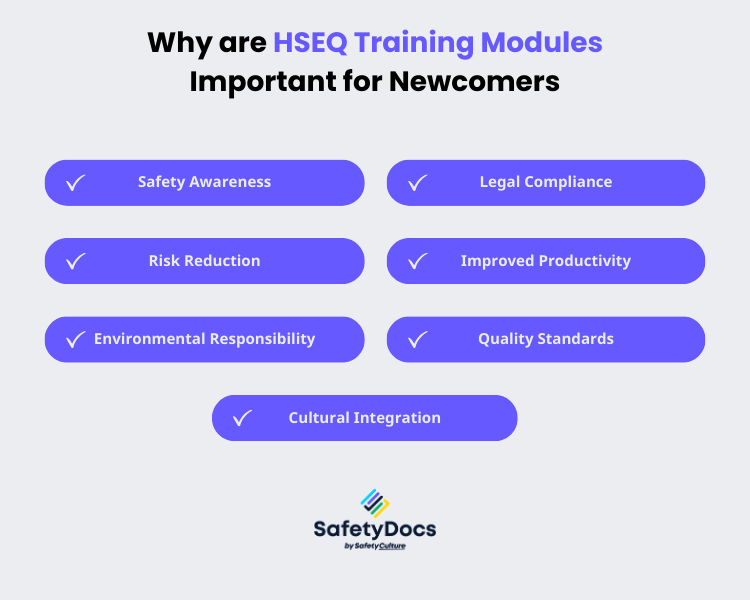A study of international university student workers in Australia found that 61% of them had yet to receive any safety training before they started working. Up to four in every five new workers need safety training, according to it. Orientation and initial training are critical for these newcomers as they often have little knowledge about workplace safety regulations, culture, or expectations.
Organisations must equip them with the necessary skills and information to ensure their safety and well-being. In this blog, we will discuss the top 10 HSEQ training modules that are essential for new employees in Australia.

10 Essential HSEQ Training Modules
To help organisations design effective HSEQ training for newcomers, here are ten essential tips that can help you start:
1. New Hire Safety Orientation
This course lays a solid groundwork for site safety and risk preparedness. It familiarises the new employee or employees with the organisation's safety policies, procedures, and expectations. It also educates them on the necessary safety equipment and how to use it.
Here are some safety documents that can assist you in designing a comprehensive safety induction orientation:
- Worker Handbook - It is a comprehensive resource that provides all the necessary information for employees. It includes the company's mission statement, values, benefits, HR policies, and employment agreements.
- Worker Training, Competency & Induction Register - this document serves as a dependable repository for recording all completed training and competencies of workers while ensuring proper induction.
2. Hazard Identification & Risk Assessment Training
This type of training teaches participants how to identify hazards in their work area and assess their risk level. They'll also learn how to mitigate or eliminate these risks through proper controls. This training is mandatory to inform employees of any dangers relating to the equipment they use.
You can utilise the Hazardous Chemicals Safe Work Method Statement template, which comprehensively addresses the hazards and corresponding controls related to the identification and management of health and safety risks while working near or handling hazardous chemicals/substances within a workplace.
3. Emergency Evacuation Procedures
This training ensures that employees know what to do in an emergency, whether a fire or natural disaster. It also covers emergency communication procedures and the location of emergency exits.
The following documents can assist you in designing a comprehensive emergency evacuation procedure:
- Emergency Response Procedure - This document offers detailed guidance on the necessary information to provide when contacting emergency services during an unforeseen event. It is a reliable resource to ensure effective communication and swift response in times of crisis.
- Emergency Response Management Plans - This plan aids in fulfilling the responsibility to create a comprehensive strategy for the business, ensuring that employees are well-prepared to handle unforeseen emergencies.
4. First Aid and CPR Training
This training teaches life-saving skills that can be used in emerging cities in the workplace and outside. It equips employees to provide immediate care for injuries or illnesses before professional help arrives.
Check out these documents for assistance in designing a comprehensive first aid and CPR training:
- First Aid Policy - This policy aims to ensure that you can quickly identify First Aid Officers (FAO) who are well-trained in assisting with any injury or illness.
- First Aid Worker Register - The document streamlines updating and organising first aid personnel details and qualifications, ensuring efficiency and organisation.
5. Personal Protective Equipment (PPE) Training
This training covers what type of protective gear is necessary for specific tasks, how to wear and inspect it for any damage or defects properly, and how to clean and maintain it. PPE training is crucial for preventing injuries and illnesses in the workplace.
Use the following document to assist in designing a comprehensive PPE training program:
- The Personal Protective Equipment (PPE) Policy can serve as a valuable resource when designing this training module. It sets out guidelines and procedures for selecting, using, and caring for PPE.
- Personal Protective Equipment (PPE) Register This document helps track the PPE issued to employees, including the type, model, size, and issue date.
6. Workplace Ergonomics and Safe Lifting Techniques
This training is essential for reducing the risk of work-related musculoskeletal disorders. It covers proper body mechanics, safe lifting techniques, and tips for maintaining good ergonomic working posture.
The following templates can assist in the design and implementation of this training module:
- Manual Handling Safe Work Method Statement - This template provides a comprehensive guideline for identifying, assessing and controlling potential manual handling hazards in the workplace.
- Manual Handling Safe Operating Procedure - This document outlines the safe procedures and methods for manually handling objects to avoid workplace injuries.
7. Fire Safety Training
This training covers fire prevention measures, safe use of fire extinguishers, evacuation procedures, and emergency communication protocols. It is crucial for ensuring employee safety and minimising damage in a fire. Here are some documents that can assist in designing a fire safety training program:
- Emergency Response Procedure - Fire - This template offers businesses a comprehensive guide on the actions their staff should follow during a fire.
- Fire Prevention and Safety Safe Operating Procedure - This document outlines the step-by-step procedures to prevent and manage fire-related incidents in the workplace. It can serve as a valuable resource when designing a fire safety training program.
8. Environmental and Chemical Safety
When working with hazardous chemicals/substances, it is crucial to have proper safety guidelines in place. It covers the identification and management of potential chemical hazards and how to handle them safely.
The following documents can assist in designing a comprehensive environmental and chemical safety training program:
- Chemicals/Dangerous Goods Management Plan - This plan outlines an organisation's commitment to ensuring a safe environment regarding hazardous chemicals, substances, and dangerous goods. I include guidelines for acquisition, storage, and disposal to minimise risks to workers and others.
- Hazardous Chemicals Safe Work Method Statement - This document covers hazards and controls for identifying and managing health and safety risks when working with dangerous chemicals/substances. New employees benefit from this document as part of training.
9. Fall Protection and Ladder Safety
This training is essential for new team members and employees who work at heights. New workers should be trained to use fall protection equipment and ladders properly. The following documents can help you start designing a comprehensive fall protection and ladder safety training program:
- Working at Height Safe Work Method Statements Pack - This pack offers contractors clear and practical guidelines for safe tasks at height. This pack includes 9 SWMS and provides comprehensive guidelines for various height-related operations.
- Working at Height Risk Assessment Checklist - Use this checklist before starting work to ensure all necessary control measures are in place. This pre-operational checklist will help them prepare thoroughly and conduct their job safely and efficiently.
10. Online Safety and Cybersecurity
New employees should receive training on protecting themselves and the organisation from online threats such as phishing scams, malware attacks, and identity theft. The following templates can help you in training new employees on online safety and cybersecurity:
- Worker Privacy Policy - This document is of utmost importance as it outlines your organisation's procedures for managing personal employee data. It covers various aspects, including data collection, security measures, and proper disposal methods.
- Information Technology (IT) Policy - This policy ensures the organisation is safeguarded against potential risks and liabilities while promoting efficient utilisation of employees' devices.
These ten essential modules cover various aspects of workplace safety, ranging from physical hazards to online threats, to help in your new hire training program. Remember, investing time and effort into proper employee training not only promotes a safe work environment but also boosts productivity and employee morale.
Let's dive deeper into HSEQ training and why they are essential for promoting workplace safety.

What is HSEQ Training?
HSEQ stands for health, safety, environment, and quality. HSEQ training is used to educate and train new employees on various hazards in the workplace and how to mitigate or eliminate them. It is a crucial part of onboarding procedures as it equips employees with essential skills and knowledge to work safely and productively.
Components of an HSEQ Training
While the specific content may vary depending on the industry and the organisation, here are some general components of HSEQ training:
- Health and Safety Regulations: Participants are educated on the key legislation and regulations that govern health and safety in their specific industry and region.
- Risk Management: This involves teaching methods to identify potential hazards, assess risks, and implement control measures to prevent accidents or incidents.
- Environmental Awareness: New employee training on the ecological impact of the organisation's operations and how to minimise it will help ensure compliance with environmental laws and regulations.
- Quality Management: Participants learn about the principles of quality management and how to apply them to improve organisational processes, products, or services.
- Emergency Response Training: Basic first aid courses and emergency response training may be included to prepare employees for potential emergencies.
- Hazardous Material Handling: Depending on the industry, there may be training on handling, storage, and disposal of hazardous materials.
- Workplace Ergonomics: Training process often includes information on how to set up a safe and efficient workspace, which can help prevent injuries related to poor ergonomics.
- Reporting Procedures: Employees learn to accurately record and report incidents, near misses, and hazards, which is crucial for maintaining an effective HSEQ system.
- Cultural Awareness: Some programs may also include sections on promoting a company culture of safety and responsibility among all employees.
- Personal Protective Equipment (PPE): Training process on the appropriate use of PPE to protect employees from job-related injuries.

Why is HSEQ Training Important for Newcomers?
Effective training sessions are crucial to prepare new employees for their roles and responsibilities in the workplace. Here are the top reasons why organisations should invest in proper HSEQ and training materials for newcomers:
Safety Awareness
This training helps newcomers understand the importance of safety in the workplace, how to identify potential hazards, and the steps to take to prevent accidents.
Legal Compliance
HSEQ training ensures that employees know and comply with health and safety laws applicable to their roles, helping the organisation avoid legal issues.
Risk Reduction
By teaching newcomers how to work safely and handle equipment properly, HSEQ training helps reduce the risk of workplace accidents and injuries.
Improved Productivity
When employees understand how to work safely, they're less likely to suffer from work-related injuries or illnesses.
Environmental Responsibility
The environmental component of HSEQ training programs teaches employees about the impact of their actions on the environment and how they can contribute to sustainability efforts.
Quality Standards
The quality component of HSEQ training helps new employees understand the organisation's quality standards and how to maintain them, leading to better products or services.
Cultural Integration
Finally, HSEQ new hire training helps new employees integrate into the company culture of safety, encouraging a collective responsibility among team members for maintaining a safe and healthy work environment.
Complete Your Employee Training Program With SafetyDocs
The safety documents mentioned above will complete your HSEQ training program. These documents from SafetyDocs by SafetyCulture provide a comprehensive guide for safe work practices and help maintain an efficient and secure workplace. Utilise these resources to their full potential, and you'll see a significant reduction in accidents, injuries, and incidents while promoting a safety culture among employees.
Remember, investing in proper HSEQ training benefits not only new hires and existing employees but also the organisation as a whole. Contact us today to learn more about our HSEQ resources.
Our team of experts is dedicated to providing accurate and informative content. Craig Cruickshank, our senior HSEQ advisor at SafetyDocs by SafetyCulture has reviewed this blog post to ensure the highest level of quality.
Learn more about Craig's work on LinkedIn for more industry insights.
Available for instant download and supplied in fully editable MS Word format for use in your business.
Please note that the above information is provided as a comment only and should not be relied on as professional, legal or financial advice.
Share This Article
